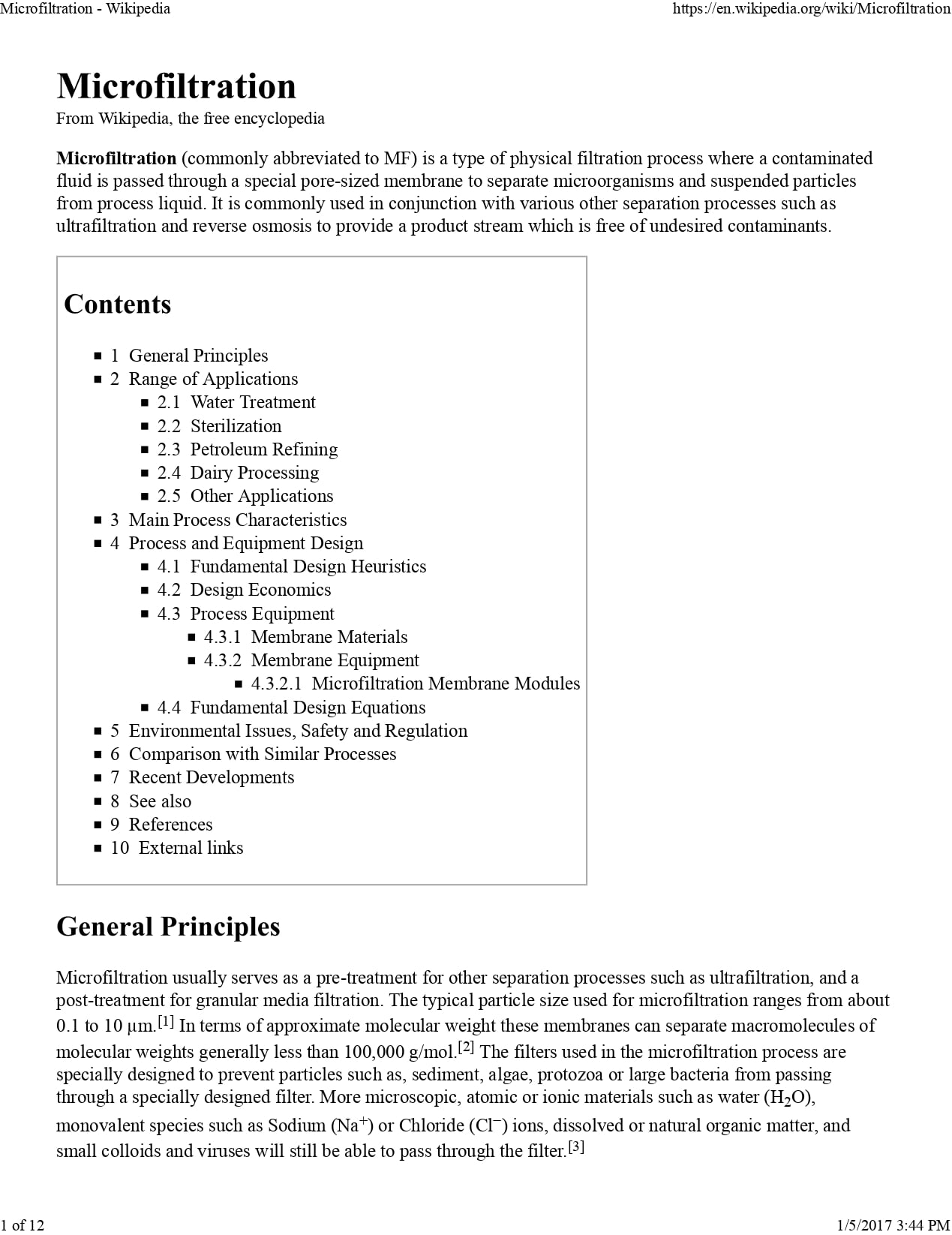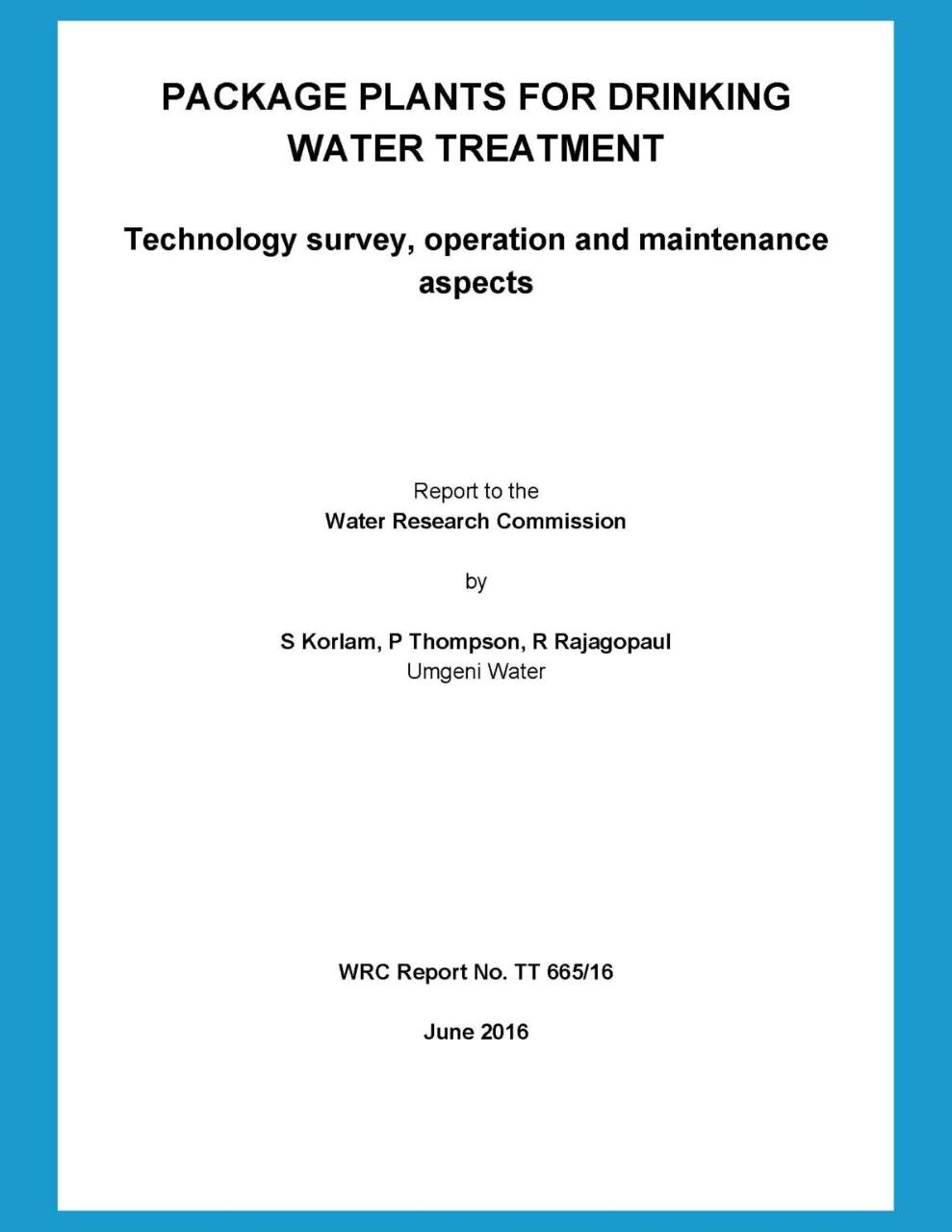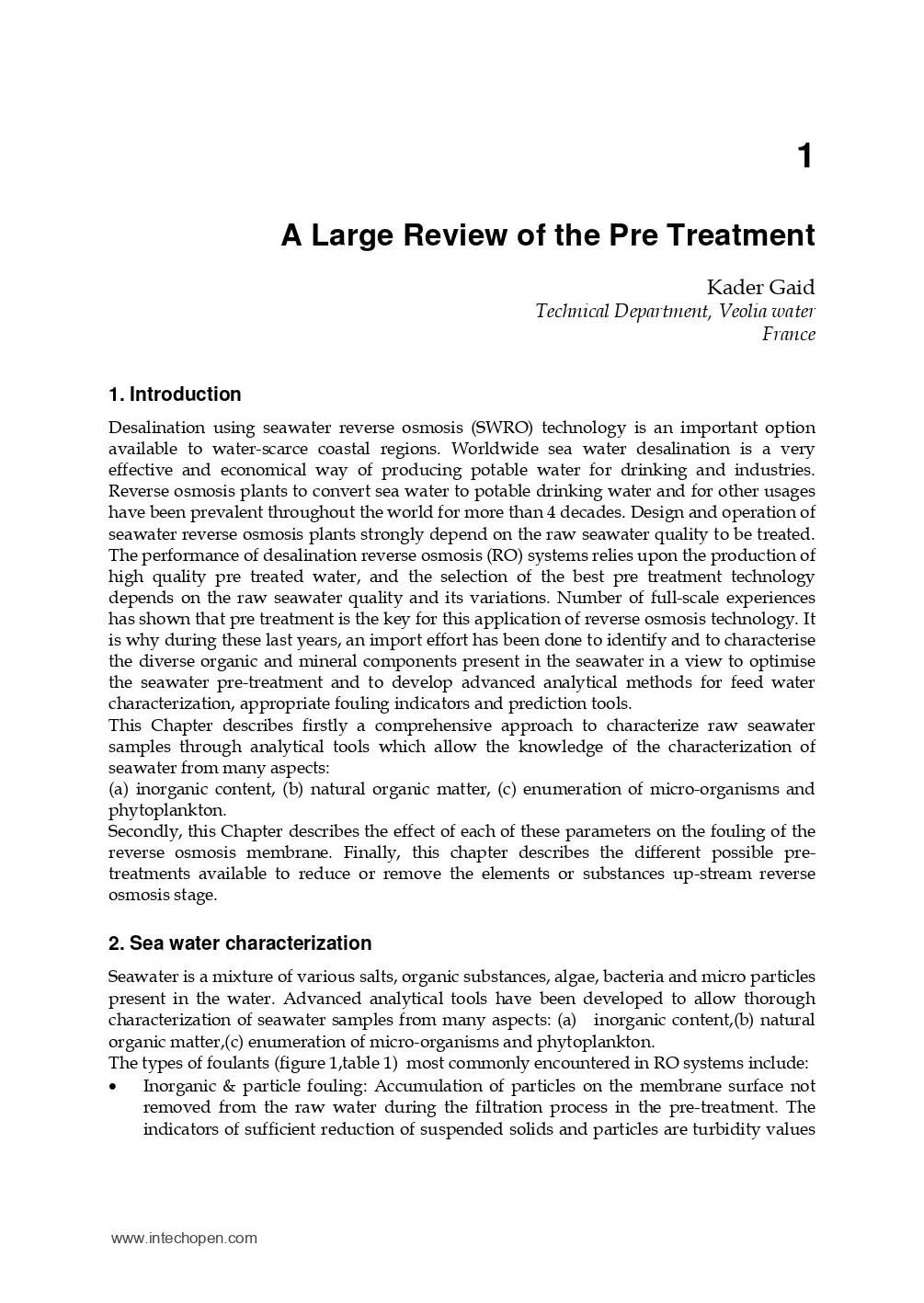Microfiltration-2017
Source: https://en.wikipedia.org/
Usually dispatched in 2 to 3 days
Usually dispatched in 2 to 3 days
Category:
Drinking Water Treatment
Only logged in customers who have purchased this product may leave a review.
Related products
An Energy-Efficient and Sustainable, Microbial Electrolysis- Deionization System for Salt and Organics Removal
The University of Tennessee, Knoxville (UTK) received funding from the Bureau of Reclamation (Reclamation) in September 2013 to investigate a novel salt and organic removal technology. Using microbial electrolysis cell (MEC) technology and salt removal via capacitive deionization (CDI) to remove organic compounds present in produced water was investigated. This project was conducted in collaboration with CAP Holdings Company (CHC), which provided expertise in CDI technology. Converting soluble organic compounds via MEC was coupled to salt removal via CDI, providing a proof of principle for synergistic salt and organic removal. Hydrogen was generated by MEC from organic compounds and used to produce renewable electricity via a polymer electrolyte membrane (PEM) fuel cell , which was then used to power the CDI cell to achieve deionization.
An Energy-Efficient and Sustainable, Microbial Electrolysis- Deionization System for Salt and Organics Removal
The University of Tennessee, Knoxville (UTK) received funding from the Bureau of Reclamation (Reclamation) in September 2013 to investigate a novel salt and organic removal technology. Using microbial electrolysis cell (MEC) technology and salt removal via capacitive deionization (CDI) to remove organic compounds present in produced water was investigated. This project was conducted in collaboration with CAP Holdings Company (CHC), which provided expertise in CDI technology. Converting soluble organic compounds via MEC was coupled to salt removal via CDI, providing a proof of principle for synergistic salt and organic removal. Hydrogen was generated by MEC from organic compounds and used to produce renewable electricity via a polymer electrolyte membrane (PEM) fuel cell , which was then used to power the CDI cell to achieve deionization.
Activated Carbon Treatment of Drinking Water
Introduction:
Activated carbon filtration (AC) is effective in reducing certain organic chemicals and chlorine in water. It can also reduce the quantity of lead in water although most lead-reducing systems use another filter medium in addition to carbon. Water is passed through granular or block carbon material to reduce toxic compounds as well as harmless taste- and odor-producing chemicals. This fact sheet discusses the principles and processes of typical activated carbon filtration systems.
Activated Carbon Treatment of Drinking Water
Introduction:
Activated carbon filtration (AC) is effective in reducing certain organic chemicals and chlorine in water. It can also reduce the quantity of lead in water although most lead-reducing systems use another filter medium in addition to carbon. Water is passed through granular or block carbon material to reduce toxic compounds as well as harmless taste- and odor-producing chemicals. This fact sheet discusses the principles and processes of typical activated carbon filtration systems.
Removal of Aluminium from Drinking Water
Aluminium in drinking water comes from natural sources and the alum used as coagulant in the water treatment process. Exposure to aluminium has been implicated in dialysis dementia, Parkinson and Alzheimer’s disease. Drinking water containing aluminium was considered to be one of the main sources of Al intake into human body. For this reason, the removal of aluminium from drinking water is vital to our health. In this study, removal of aluminium was carried out by using a chelating resin.
Removal of Aluminium from Drinking Water
Aluminium in drinking water comes from natural sources and the alum used as coagulant in the water treatment process. Exposure to aluminium has been implicated in dialysis dementia, Parkinson and Alzheimer’s disease. Drinking water containing aluminium was considered to be one of the main sources of Al intake into human body. For this reason, the removal of aluminium from drinking water is vital to our health. In this study, removal of aluminium was carried out by using a chelating resin.
Best Practices Manual for Small Drinking Water Systems
New regulations pursuant to The Drinking Water Safety Act, administered by the Office of Drinking Water, resulted in changes to the approval, licensing, monitoring, record-keeping and reporting requirements for drinking water systems in Manitoba. It is recognized that many small drinking water systems may not have the same level of access to technical services and resources as larger public water systems. This manual of best practices (a comprehensive, integrated and co-operative approach to continuous improvement of all facets of operations for delivering superior standards of performance) is to assist small drinking water systems with regulatory, management and operational challenges.
Best Practices Manual for Small Drinking Water Systems
New regulations pursuant to The Drinking Water Safety Act, administered by the Office of Drinking Water, resulted in changes to the approval, licensing, monitoring, record-keeping and reporting requirements for drinking water systems in Manitoba. It is recognized that many small drinking water systems may not have the same level of access to technical services and resources as larger public water systems. This manual of best practices (a comprehensive, integrated and co-operative approach to continuous improvement of all facets of operations for delivering superior standards of performance) is to assist small drinking water systems with regulatory, management and operational challenges.
Biofilm Control Study
Darigold operates a milk products facility in Lynden, Washington. Production processes include evaporation of milk, which generates what is referred to as condensate of whey (COW) water. COW water contains low molecular weight organic compounds including traces of lactic acid, alcohols, acetoin, and non-protein nitrogen (Möslang, 2017). COW water and non-contact cooling water from the Darigold Lynden facility are currently discharged to Outfall 001, which combines with stormwater and the City of Lynden’s wastewater treatment plant (WWTP) effluent discharge to the Nooksack River through the City’s outfall. Darigold’s discharge is regulated under National Pollutant Discharge Elimination System (NPDES) Permit No. WA0002470 administered by the Washington Department of Ecology (Ecology). In the future, Darigold’s COW Water and non-contact cooling water will be directly discharged to the Nooksack River in a new outfall pipe (Outfall 002) currently being constructed by the City.
Biofilm Control Study
Darigold operates a milk products facility in Lynden, Washington. Production processes include evaporation of milk, which generates what is referred to as condensate of whey (COW) water. COW water contains low molecular weight organic compounds including traces of lactic acid, alcohols, acetoin, and non-protein nitrogen (Möslang, 2017). COW water and non-contact cooling water from the Darigold Lynden facility are currently discharged to Outfall 001, which combines with stormwater and the City of Lynden’s wastewater treatment plant (WWTP) effluent discharge to the Nooksack River through the City’s outfall. Darigold’s discharge is regulated under National Pollutant Discharge Elimination System (NPDES) Permit No. WA0002470 administered by the Washington Department of Ecology (Ecology). In the future, Darigold’s COW Water and non-contact cooling water will be directly discharged to the Nooksack River in a new outfall pipe (Outfall 002) currently being constructed by the City.
A Study on the Introduction of Artificial Intelligence Technology in the Water Treatment Process
Today, we stand in front of a huge wave of change named the "Fourth industrial revolution." Key technologies of the Fourth Industrial Revolution include artificial intelligence, the Internet of Thing (IoT), cloud computing, big data analysis, etc. These technologies will lead to an intelligent information society, and platform services will change every aspect of society from economic and work. This paper proposes several introductions of Artificial Intelligence Technology to improve water management.
A Study on the Introduction of Artificial Intelligence Technology in the Water Treatment Process
Today, we stand in front of a huge wave of change named the "Fourth industrial revolution." Key technologies of the Fourth Industrial Revolution include artificial intelligence, the Internet of Thing (IoT), cloud computing, big data analysis, etc. These technologies will lead to an intelligent information society, and platform services will change every aspect of society from economic and work. This paper proposes several introductions of Artificial Intelligence Technology to improve water management.
Package Plants For Drinking Water Treatment
In efforts to make package plants more compact, affordable and easier to operate and maintain, it has been noted that the design and performance of some of these plants containing conventional treatment processes is sometimes compromised if technical expertise in this regard is lacking. Generally, there are several risks associated with poorly designed treatment systems, including loss of production, poor safety and compromised equipment and process unit efficiency with associated higher operating and maintenance costs. These risks have more severe consequences in the case of desalination (including water reclamation and water re-use) package plants. The objective of this project is to develop a set of guidelines to assist municipalities, water treatment practitioners, designers and package plant manufacturers in the specification and design of appropriate unit processes and operating parameters to fit the influent water quality, operating environment and other special treatment requirements.
Package Plants For Drinking Water Treatment
In efforts to make package plants more compact, affordable and easier to operate and maintain, it has been noted that the design and performance of some of these plants containing conventional treatment processes is sometimes compromised if technical expertise in this regard is lacking. Generally, there are several risks associated with poorly designed treatment systems, including loss of production, poor safety and compromised equipment and process unit efficiency with associated higher operating and maintenance costs. These risks have more severe consequences in the case of desalination (including water reclamation and water re-use) package plants. The objective of this project is to develop a set of guidelines to assist municipalities, water treatment practitioners, designers and package plant manufacturers in the specification and design of appropriate unit processes and operating parameters to fit the influent water quality, operating environment and other special treatment requirements.
Analysis of the Membrane Alternatives Suitable for Kvarnagården Water Treatment Plant.
In this study surveys to membrane manufacturers and water treatment plants regarding the performance of different membrane alternatives have been carried out from January to April 2012. The work has been done as a part of a study of the different membrane alternatives suitable for Kvarnagården Water Treatment Plant. Also in the study experiments regarding water quality parameters have been carried out at the water laboratory at Chalmers University of Technology. The project is carried out at the Department of Civil and Environmental Engineering and is connected to the company VIVAB, the company in charge of Kvarnagården Water Treatment Plant.
Analysis of the Membrane Alternatives Suitable for Kvarnagården Water Treatment Plant.
In this study surveys to membrane manufacturers and water treatment plants regarding the performance of different membrane alternatives have been carried out from January to April 2012. The work has been done as a part of a study of the different membrane alternatives suitable for Kvarnagården Water Treatment Plant. Also in the study experiments regarding water quality parameters have been carried out at the water laboratory at Chalmers University of Technology. The project is carried out at the Department of Civil and Environmental Engineering and is connected to the company VIVAB, the company in charge of Kvarnagården Water Treatment Plant.
A Large Review of the Pre Treatment
Introduction:
Desalination using seawater reverse osmosis (SWRO) technology is an important option available to water-scarce coastal regions. Worldwide sea water desalination is a very effective and economical way of producing potable water for drinking and industries. Reverse osmosis plants to convert sea water to potable drinking water and for other usages have been prevalent throughout the world for more than 4 decades. Design and operation of seawater reverse osmosis plants strongly depend on the raw seawater quality to be treated. The performance of desalination reverse osmosis (RO) systems relies upon the production of high quality pre treated water, and the selection of the best pre treatment technology depends on the raw seawater quality and its variations. Number of full-scale experiences has shown that pre treatment is the key for this application of reverse osmosis technology. It is why during these last years, an import effort has been done to identify and to characterise the diverse organic and mineral components present in the seawater in a view to optimise the seawater pre-treatment and to develop advanced analytical methods for feed water characterization, appropriate fouling indicators and prediction tools. This Chapter describes firstly a comprehensive approach to characterize raw seawater samples through analytical tools which allow the knowledge of the characterization of seawater from many aspects: (a) inorganic content, (b) natural organic matter, (c) enumeration of micro-organisms and phytoplankton. Secondly, this Chapter describes the effect of each of these parameters on the fouling of the reverse osmosis membrane. Finally, this chapter describes the different possible pre treatments available to reduce or remove the elements or substances up-stream reverse osmosis stage.
A Large Review of the Pre Treatment
Introduction:
Desalination using seawater reverse osmosis (SWRO) technology is an important option available to water-scarce coastal regions. Worldwide sea water desalination is a very effective and economical way of producing potable water for drinking and industries. Reverse osmosis plants to convert sea water to potable drinking water and for other usages have been prevalent throughout the world for more than 4 decades. Design and operation of seawater reverse osmosis plants strongly depend on the raw seawater quality to be treated. The performance of desalination reverse osmosis (RO) systems relies upon the production of high quality pre treated water, and the selection of the best pre treatment technology depends on the raw seawater quality and its variations. Number of full-scale experiences has shown that pre treatment is the key for this application of reverse osmosis technology. It is why during these last years, an import effort has been done to identify and to characterise the diverse organic and mineral components present in the seawater in a view to optimise the seawater pre-treatment and to develop advanced analytical methods for feed water characterization, appropriate fouling indicators and prediction tools. This Chapter describes firstly a comprehensive approach to characterize raw seawater samples through analytical tools which allow the knowledge of the characterization of seawater from many aspects: (a) inorganic content, (b) natural organic matter, (c) enumeration of micro-organisms and phytoplankton. Secondly, this Chapter describes the effect of each of these parameters on the fouling of the reverse osmosis membrane. Finally, this chapter describes the different possible pre treatments available to reduce or remove the elements or substances up-stream reverse osmosis stage.
Adsorbent Material Used In Water Treatment-A Review
Adsorption method of purify water relies mainly on the adsorbent to adsorb the impurities in the water, this paper introduces the latest research progress both at home and abroad, such as activated carbon, chitosan, zeolites, clay minerals plant-based, industrial waste . These adsorbent type will play a more and more important role in water treatment in the future.
Adsorbent Material Used In Water Treatment-A Review
Adsorption method of purify water relies mainly on the adsorbent to adsorb the impurities in the water, this paper introduces the latest research progress both at home and abroad, such as activated carbon, chitosan, zeolites, clay minerals plant-based, industrial waste . These adsorbent type will play a more and more important role in water treatment in the future.















Reviews
There are no reviews yet.